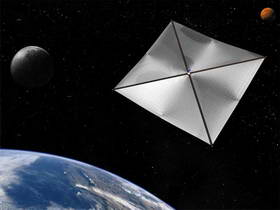I’m Fraser Cain, and I’m a sailor. Well, okay, I’ve got a sailboat that I take out on the water when its warm and the weather’s nice here on Vancouver Island. I think it’s one of the reasons I absolutely love the idea of a solar sail.
Here’s how they work: Light is made up of photons. Even though they have no mass at rest, they have momentum when they’re moving, well, light speed. When they reflect off a surface, like a mirror or a shiny piece of metal, they impart some of this momentum to that surface. This effect is negligible here on Earth, but out in space, with forces perfectly in balance, that additional momentum can really add up.
A spacecraft flying to Mars gets pushed off course by several thousand kilometers because of light pressure from the Sun.If mission planners didn’t compensate for this drift, their spacecraft would miss the planet, or even worse, crash into it. Even though the total amount of pressure per square meter on a solar sail is minuscule, it’s constantly streaming from the Sun, and it’s totally free….And propulsion that you don’t have to carry with you is the best kind there is.
This is more than just an idea. Solar sails have already been launched and deployed in space. The Japanese Ikaros satellite unfurled a 14-meter solar sail back in 2010. NASA launched its own Nanosail-D spacecraft in 2011. An even bigger solar sail, the Sunjammer, is planned for launch in 2014. The Planetary Society is working on a solar sail project as well.
The closer to the Sun you are, the better they work. In fact, a solar sail would be an ideal vehicle to explore the regions of Mercury and Venus, since they receive so much radiation. But you’re probably wondering how a solar sail could get down to those planets because light is streaming from the Sun in all directions. It’s all about raising and lowering your orbit. If you want to raise your orbit around an object, all you have to do is speed up. And if you want to lower your orbit, you just need to slow down.
A solar sail launched from Earth would start out with the same orbital velocity around the Sun as the Earth. To get into a higher orbit, it tilts the sail so that the light from the Sun speeds it up. And to get into a lower orbit, it tilts in the opposite direction, and the light from the Sun acts like a brake.

A solar sail might even be the ideal spacecraft to make the journey to another star. An interstellar solar sail could lower its orbit so that it’s just above the surface of the Sun. Then, it would unfurl the full sail and capture the most possible photons. A series of powerful laser beams would then target the sail and increase its velocity to a significant fraction of the speed of light.
Of course, you’d need a solar sail thousands of kilometers across, made of a material thinner than a human hair, and lasers putting out more energy than all of humanity. The idea is still intriguing, even though it’s well outside our current technology. Once this technology gets better tested, we’ll to see many more missions employ solar sails as part of their propulsion system.


Solar sails are very different to rockets. A rocket is a great big thing, mostly made of fuel. If you payload is a few Kg, then it will be a significant part of a multi-stage rocket. You can use some of your payload mass for an even smaller rocket to go a bit faster, but you won’t get much.
Suppose we fly using solar radiation alone. Our probe could slow down as it neared its destination, and fly back again. It is hard to transmit information over inter-stellar distances without using enormous energies, but it could store the data on very light molecular-scaled memory and fly back to us again propelled by the other star, without the giant lasers.
Will this take hundreds of years or tens of thousands for a round trip to the stars? It is hard to know without knowing the limits of ultra-light sail material. There are some estimates at the back of ….
http://www.u3p.net/projets/doc/HoustonU3P.pdf
The final graph shows velocities over 50 000 Km/s should be possible, which is about 16% of the speed of light. So, there and back to the nearest star would probably take at least 60 years. That may sound like a long time, but we have been listening to Voyager 1 for 37 years now.
Lol! Love the sweater Fraser. Very funny.
BTW, I have an important question: do the lasers have to be attached to sharks in order for the solar sail to work? Cause, that would be really cool.
I love Fraser’s style and all he has done to popularize space.
My suggestion to enhance the show is to see his kids and their friends bombard him with snowballs at the end of one of his talks, shouting:
– “Protect your planet against this comet, Fraser!”
– “Warm this globe, Fraser!”
– “Here’s a merging orbit for you, Fraser!”
– “Open your black hole and eat this, Fraser!”
I bet he’d go supernova and melt those kids with his sheer mass and force of expansion…